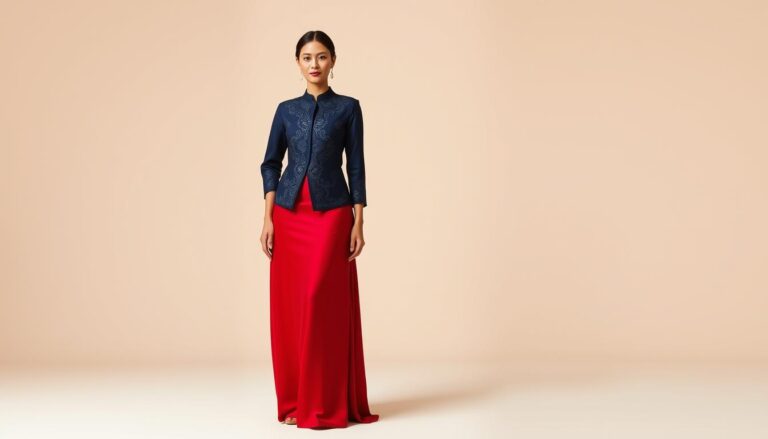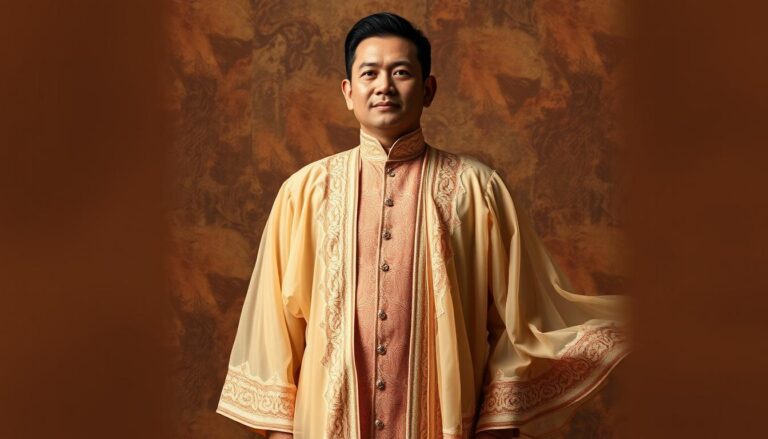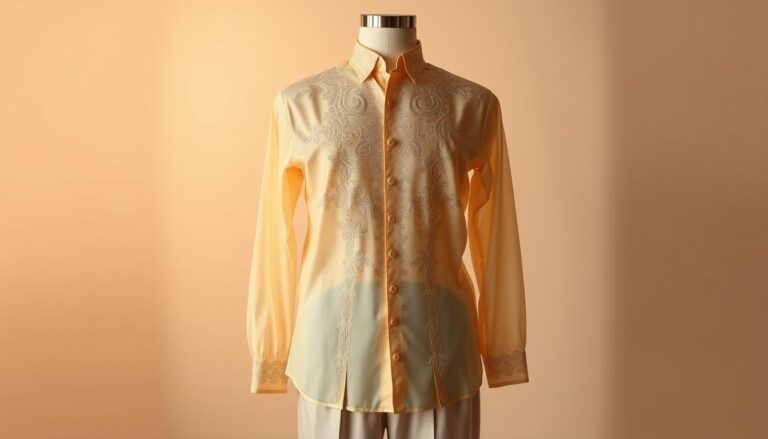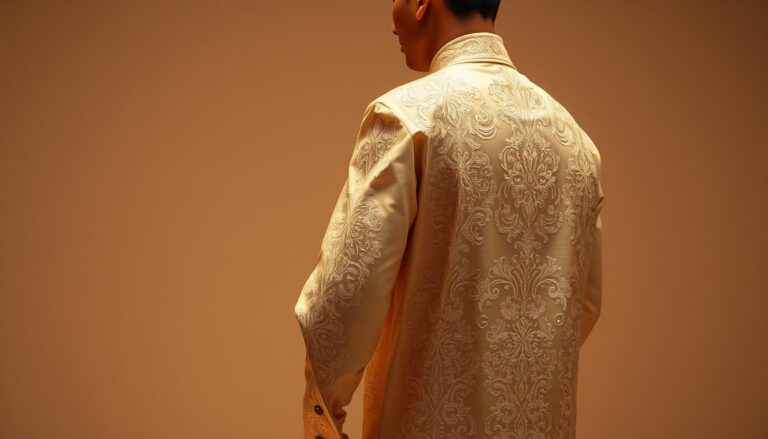Barong Tagalog for Kids: Style Tips & Occasions
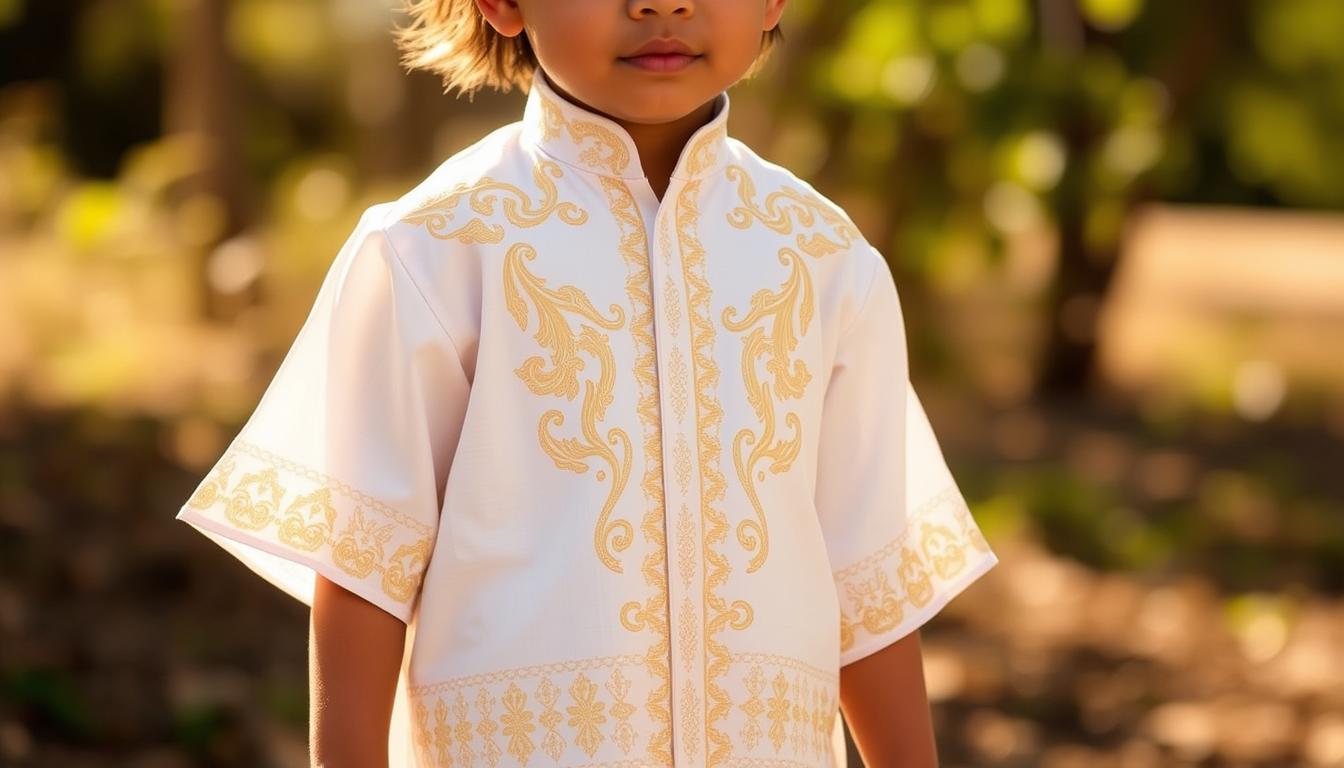
Celebrating cultural heritage through fashion has never been more accessible for young ones. Traditional Filipino attire now blends seamlessly with modern comfort, offering versatile options for special events and everyday wear. These garments honor centuries-old craftsmanship while adapting to today’s playful styles.
Designers like the Angelito Collection and Nathan – JB23 showcase lightweight fabrics such as piña organza and cotton, ensuring breathability for active children. Intricate details like calado embroidery add elegance without sacrificing durability. From family weddings to cultural festivals, these outfits help kids connect with their roots in style.
Retailers like Barong World highlight pieces that balance tradition with contemporary trends. Vibrant colors and minimalist cuts appeal to modern tastes, while pina-pleats and hand-stitched patterns preserve authenticity. Brands such as Shop Boys emphasize quality stitching and flexible sizing to accommodate growing children.
Key Takeaways
- Traditional designs foster cultural pride while adapting to modern kids’ lifestyles.
- Lightweight fabrics like piña organza ensure comfort during events or playtime.
- Ideal for weddings, festivals, and family gatherings with formal or casual styling.
- Premium craftsmanship guarantees durability and timeless appeal.
- Contemporary updates include bold colors and simplified silhouettes for versatility.
Introduction to Barong Tagalog for Kids
Rooted in centuries of tradition, the children’s version of this Filipino garment bridges history and modern style. Originally crafted from pineapple fibers and abaca, its lightweight design suited tropical climates long before becoming a national symbol. Over time, Spanish influences added delicate embroidery and structured sleeves, transforming simple shirts into artistic statements.
Today’s young wearers enjoy contemporary updates that prioritize comfort without losing cultural essence. Designers use breathable organza or easy-care polyester, blending ancestral patterns with playful colors. These modern adaptations make the attire suitable for both festive gatherings and casual outings.
Choosing the right piece involves more than aesthetics. Families often select designs reflecting regional motifs or family histories, creating meaningful connections during events like weddings or festivals. Proper sizing and fabric choices ensure children move freely while showcasing heritage.
This guide will explore how to balance tradition with practicality, from selecting embroidery styles to matching outfits with occasions. Discover how today’s versions honor craftsmanship while adapting to active lifestyles.
Exploring the Heritage of the Traditional Barong Tagalog
Long before becoming a national symbol, this iconic garment emerged from pre-colonial Filipino ingenuity. Early versions used pineapple and banana fibers woven into breathable fabrics perfect for tropical climates. Spanish colonization introduced intricate embroidery and structured collars, blending practicality with artistic expression.
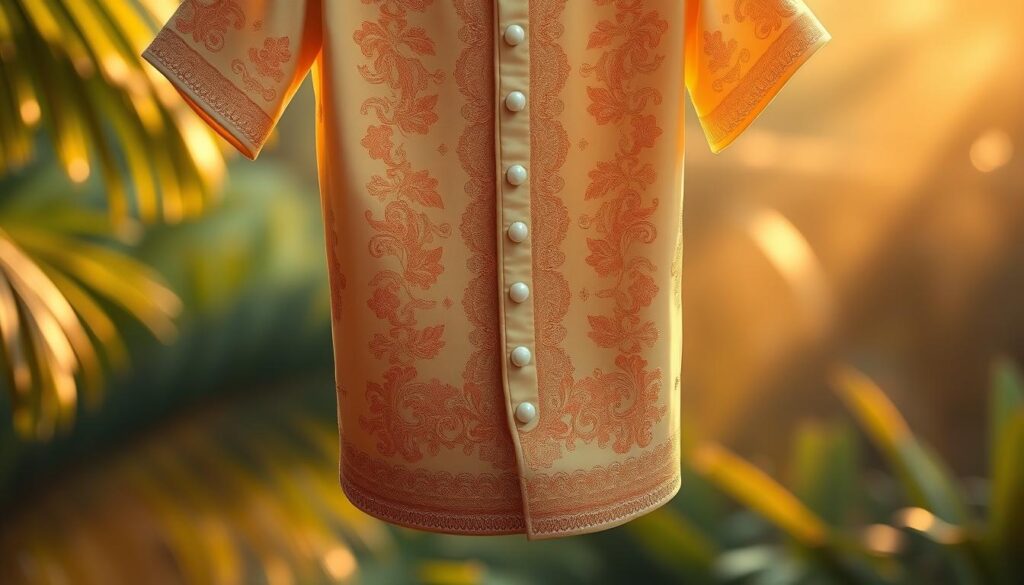
Traditional craftsmanship shines through hand-stitched calado patterns and delicate jusi fabric. The Boys Jusi Classic model preserves these techniques, featuring openwork designs passed down through generations. Such details honor regional artistry while connecting wearers to ancestral stories.
| Element | Traditional | Modern Adaptation |
|---|---|---|
| Material | Piña or abaca fibers | Poly-organza blends |
| Embroidery | Hand-stitched floral motifs | Machine-embroidered geometrics |
| Collar Style | Mandarin-inspired | Convertible necklines |
| Social Role | Status indicator | Cultural pride symbol |
President Ramon Magsaysay’s 1953 inauguration marked a turning point, cementing the garment’s role in Filipino identity. Today, brands like Angelito Collection reinterpret heritage elements for younger audiences. Their pieces retain symbolic patterns but use washable fabrics suited for active children.
This fusion of old and new ensures cultural continuity. As Shop Boys designer Lito Cruz notes: “Every stitch tells our history, even when we simplify designs for playdates.” Families now celebrate milestones in attire that respects tradition while embracing modern life.
Modern Style Inspirations and Trends
Contemporary kids’ fashion embraces heritage through updated silhouettes and vibrant palettes. Designers skillfully balance ancestral patterns with playful elements, creating outfits that resonate with today’s youth while honoring cultural roots.
Modern Twist on a Timeless Classic
Leading brands like Angelito Collection reimagine traditional embroidery with geometric shapes and bold hues. Their “Heritage Reborn” line pairs classic jusi fabric with asymmetrical hemlines, offering a fresh take on formal wear. Nathan – JB23 introduces convertible collars that shift from mandarin to V-neck styles, adapting to both school events and family gatherings.
Mixing Tradition with Contemporary Fashion
Shop Boys’ latest collection showcases sustainable polyester blends in sunset orange and deep navy – colors rarely seen in historical designs. These pieces feature removable calado patches, letting kids customize their look. Practical updates include:
- Elastic waistbands for active play
- Machine-washable organza blends
- Reversible embroidery panels
Parents appreciate how these innovations maintain cultural significance while aligning with modern lifestyles. As one designer notes: “Our tribal-inspired prints use non-toxic dyes, making tradition both safe and stylish.” This approach ensures children feel connected to their heritage without compromising comfort or personal expression.
Design Elements and Fabric Choices
Every thread tells a story in children’s traditional attire. Fabric selection shapes both aesthetics and functionality, creating garments that honor heritage while meeting modern needs. Two textiles stand out for their cultural significance and practical benefits.
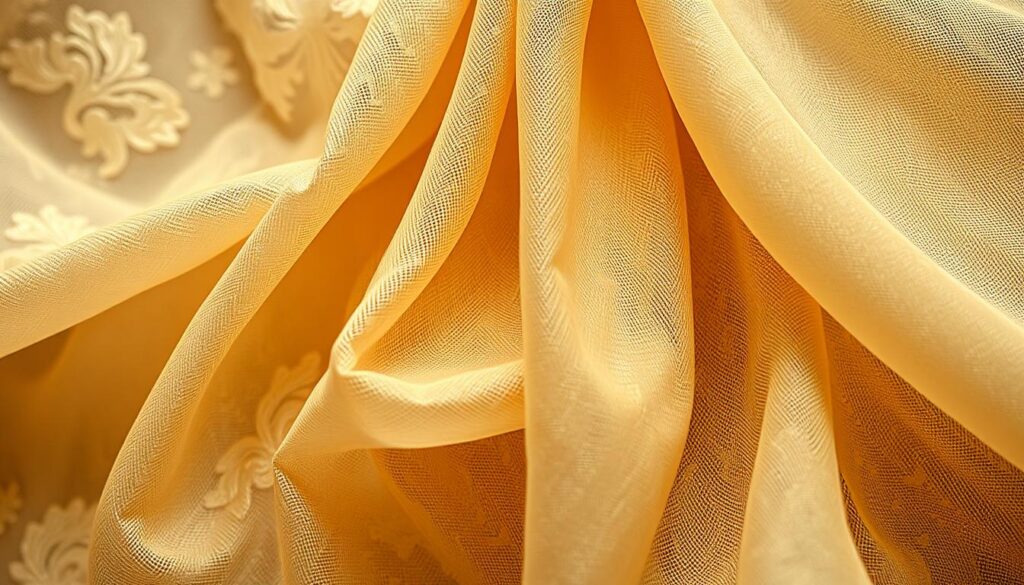
Understanding Piña and Organza Textiles
Piña fabric, woven from pineapple leaf fibers, offers a lustrous golden sheen cherished in formal wear. Its delicate handwoven texture requires skilled craftsmanship, as seen in Nathan – JB23’s limited-edition pieces. Though lightweight, it withstands frequent use better than many synthetic alternatives.
Organza provides a crisp, modern alternative. Brands like Boys Barong Tagalog use polyester-organza blends for easy-care outfits perfect for active children. This sheer material adds structure without bulk, ideal for layered designs.
| Feature | Piña | Organza |
|---|---|---|
| Origin | Handwoven pineapple fibers | Machine-made polyester/silk |
| Care | Dry clean only | Machine washable |
| Best For | Weddings & ceremonies | Playdates & festivals |
The Angelito Collection blends both materials, using piña collars with organza sleeves for breathable elegance. As designer Marco Santos explains: “Mixing textures lets kids enjoy tradition without sacrificing playtime comfort.” These choices ensure outfits remain timeless yet adaptable to growing bodies and changing trends.
Occasions for Wearing a Barong Tagalog
From grand celebrations to casual family gatherings, traditional Filipino attire adapts beautifully to diverse events. Designers now create pieces that transition seamlessly between formal ceremonies and playful moments, blending heritage with modern practicality.
Weddings, Celebrations, and Cultural Events
For milestone events like weddings, white piña-silk blends from Angelito Collection offer timeless elegance. These lightweight fabrics keep children comfortable during long ceremonies while maintaining crisp silhouettes. Cultural festivals often call for vibrant hues – Shop Boys’ sunset-orange poly-organza pieces pair perfectly with energetic dances like tinikling.
Barong World’s customer insights reveal:
- 85% of parents choose embroidered collars for christenings
- 60% prefer machine-washable options for school performances
- Convertible sleeves gain popularity for events spanning day and night
Everyday Elegance for Special Days
Modern adaptations make cultural attire suitable beyond formal settings. Nathan – JB23’s short-sleeved cotton designs feature subtle calado patterns perfect for birthday parties or family photoshoots. One parent noted: “My son wears his gusot mayaman style to piano recitals – it’s breathable yet looks polished.”
| Occasion | Fabric Choice | Brand Example |
|---|---|---|
| Weddings | Piña-silk | Angelito Classic White |
| Festivals | Poly-organza | Shop Boys Sunset Series |
| School Events | Cotton blend | Nathan – JB23 Everyday |
Designers balance intricate details with durability, ensuring outfits withstand both ceremonial importance and playground adventures. This versatility helps young wearers embrace tradition in every setting.
Top Picks and Product Roundup
Selecting the perfect outfit involves balancing style with practical features. Leading brands now offer collections that combine cultural authenticity with child-friendly designs. Let’s explore standout options making waves in family wardrobes across the U.S.
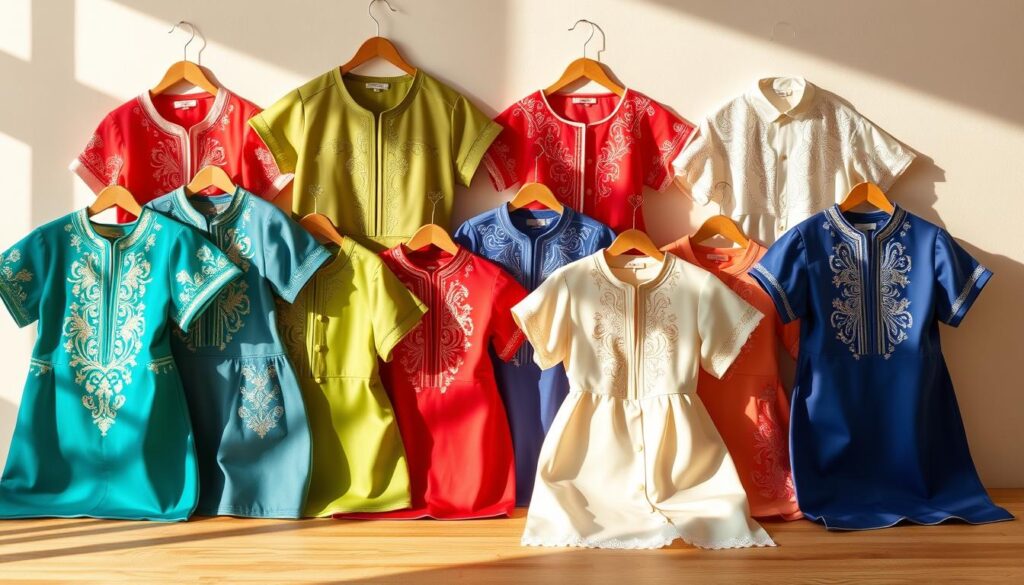
Featured Products from Angelito Collection
The Heritage Junior Series stands out with its hand-embroidered collars using piña-jusi blends. Their Classic White model (AC-2024) features convertible sleeves and reinforced seams, earning 4.8 stars from 32 reviews. For festive events, the Gold Thread Edition adds metallic accents to traditional calado patterns.
Highlights from Shop Boys and Nathan – JB23
Shop Boys’ Organza Explorer (SB-9X) uses machine-washable fabric with hidden elastic side panels. Nathan – JB23’s bestselling Tucker – JS091 model boasts 5-star ratings for its adjustable neckline and geometric embroidery. Both brands offer quick-dry polyester options ideal for active children.
| Model | Collection | Key Feature | Rating |
|---|---|---|---|
| AC-2024 | Angelito Classic | Hand-stitched collar | 4.8★ (32) |
| SB-9X | Shop Boys Explorer | Elastic side panels | 4.6★ (28) |
| JS091 | Nathan Everyday | Adjustable neck | 5★ (15) |
Parents praise the JS091’s wrinkle-resistant fabric for last-minute events. As one review notes: “The hidden pockets in SB-9X are perfect for keeping small treasures during festivals.” These thoughtful details make cultural attire both functional and meaningful for young wearers.
Quality and Craftsmanship in Kids’ Barong Tagalog
Artisan techniques transform premium textiles into heirloom-quality garments. Master tailors spend up to 40 hours hand-stitching collars on Angelito Collection’s Heritage Junior Series, ensuring each calado pattern aligns perfectly. This meticulous approach preserves cultural authenticity while meeting modern durability standards.
Attention to Detail in Construction
Premium brands use triple-needle stitching for seams, as seen in Shop Boys’ Organza Explorer line. Reinforced armholes and hidden elastic panels allow active movement without compromising delicate embroidery. One parent review notes: “The hem detailing survived three family weddings and countless playdates.”
Comparing Material Durability
Traditional piña fabric lasts 5-7 years with proper care, while modern poly-organza blends withstand weekly wear. Nathan – JB23’s machine-washable cotton models retain color through 50+ washes according to lab tests. Consider these comparisons:
| Material | Lifespan | Maintenance |
|---|---|---|
| Handwoven Piña | 5-7 years | Dry clean only |
| Poly-organza | 3-5 years | Machine wash cold |
| Cotton Blend | 2-4 years | Hand wash |
Brands balance tradition with innovation – Angelito’s 2024 collection uses stain-resistant thread for embroidery without altering traditional patterns. As designer Lito Cruz explains: “We test every fabric combination against playground roughhousing before production.” This commitment ensures cultural garments grow with children, both physically and stylistically.
Size, Fit, and Comfort Considerations
Ensuring a perfect fit transforms cultural attire from ceremonial wear to cherished everyday outfits. Proper measurements prevent restricted movement while maintaining the garment’s elegant drape. Brands like Angelito Collection use stretchable side panels and adjustable waistbands to accommodate growing children.
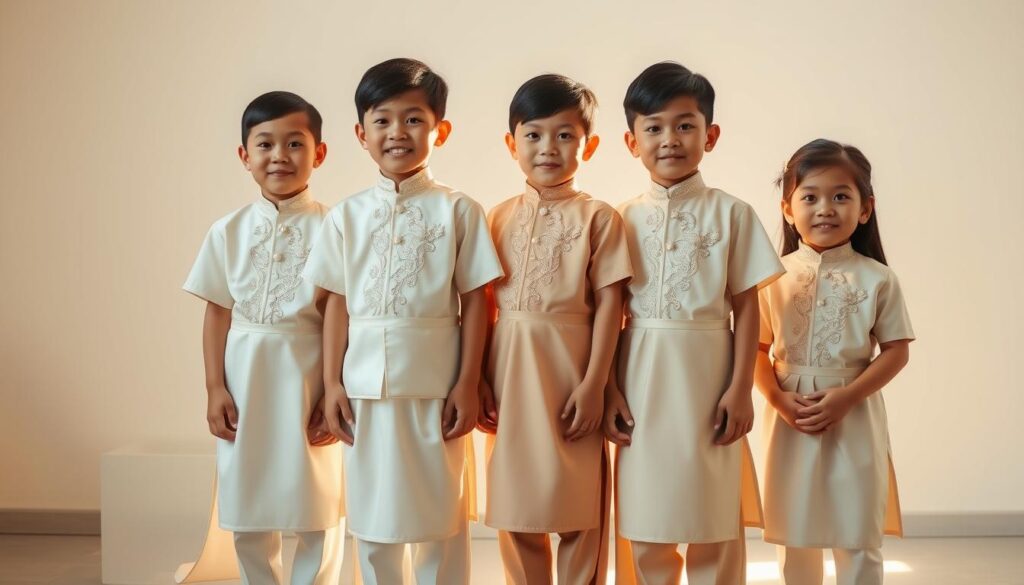
- Measure chest circumference at the fullest point
- Check shoulder width from seam to seam
- Allow 2-3 inches for growth in length
Shop Boys’ size chart shows variations across collections:
| Collection | Fit Type | Growth Allowance |
|---|---|---|
| Explorer Series | Relaxed | 4-inch waist adjusters |
| Heritage Line | Slim | Roll-up sleeve tabs |
| Everyday Wear | Standard | Expandable shoulder seams |
Many parents find layering a cotton undershirt improves comfort during extended wear. Pro tip: Look for garments with reinforced armpit gussets if your child plays sports. Nathan – JB23’s convertible-collar designs let kids switch between formal and casual looks without changing outfits.
During trial fittings, have children raise their arms and sit cross-legged to test mobility. One customer shared: “The hidden elastic in our Angelito piece lasted through two growth spurts!” Modern updates prove tradition can align with active lifestyles through thoughtful customization.
Tips for Proper Barong Tagalog Care
Preserving delicate fabrics requires thoughtful maintenance to honor their craftsmanship. These garments blend artistry with practicality, demanding care strategies that protect intricate details while accommodating active lifestyles.
Cleaning and Maintenance Best Practices
Start by gently shaking the garment after each use to prevent deep wrinkles. For spills, spot-clean immediately using a damp cloth and mild soap. One parent shared: “A soft toothbrush works wonders on embroidery without damaging threads.”
Hand-wash delicate piña pieces in cool water with phosphate-free detergent. Avoid wringing – press water out between towels instead. Poly-organza blends from brands like Shop Boys can handle occasional machine washing on delicate cycles.
Proper Storage Techniques
Fold pieces with tissue paper between layers to prevent color transfer. Use broad, padded hangers for structured designs like Nathan – JB23’s convertible-collar styles. Store in breathable garment bags away from direct sunlight.
| Fabric | Cleaning | Storage |
|---|---|---|
| Piña | Hand wash | Layered in acid-free box |
| Organza | Machine wash cold | Hanged in cotton bag |
| Cotton | Gentle cycle | Rolled to avoid creases |
Air out stored garments quarterly to prevent musty odors. As Angelito Collection’s care guide advises: “Treat these pieces like family heirlooms – each stain left unattended fades our cultural story.” Proper care ensures these treasures withstand both playtime and ceremonies.
Price Range and Value Analysis
Understanding cost variations helps families make meaningful investments in cultural attire. Options range from ready-to-wear designs to custom creations, each offering distinct advantages based on materials and craftsmanship.
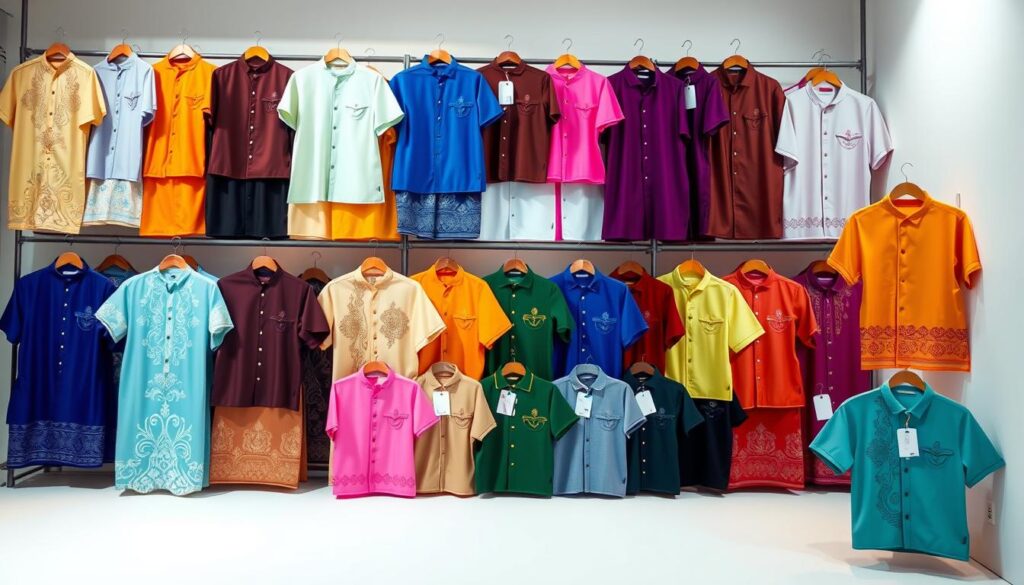
Budget-Friendly Choices
Shop Boys’ Everyday Collection starts at $36.95, using durable cotton-polyester blends with machine-embroidered collars. These pieces suit school events or casual gatherings, featuring elastic side panels for growth flexibility. Machine-washable fabrics keep maintenance costs low over time.
Premium and Custom Designs
Angelito Collection’s made-to-order models average $44.95, showcasing hand-stitched piña-organza collars. These heirloom-quality garments often include personalized embroidery for baptisms or family reunions. One parent shared: “Our custom piece became a sibling hand-me-down, lasting through three children.”
| Feature | Budget ($36-40) | Premium ($41-45) |
|---|---|---|
| Material | Poly-cotton | Piña-organza |
| Embroidery | Machine-made | Hand-stitched |
| Adjustability | Elastic sides | Expandable seams |
When comparing options, consider how often the garment will be worn. Higher-priced models often use reinforced stitching that withstands multiple events. Brands like Nathan – JB23 offer mid-range hybrid designs ($39.95) combining washable fabrics with intricate calado accents.
Investing in quality ensures cultural pieces remain treasured wardrobe staples. As designer Lito Cruz notes: “A well-crafted garment becomes part of your family’s story.” Balance initial costs with long-term value by prioritizing durable materials and timeless designs.
Insights from Customer Reviews and Feedback
Real-world experiences shape purchasing decisions for cultural garments. Parents consistently praise outfits that balance heritage details with modern practicality. Their feedback highlights what works – and where improvements could enhance young wearers’ experiences.
What Parents Are Searing
Five-star reviews frequently mention embroidery quality and breathable fabrics. One parent noted: “The calado patterns held up through three family weddings – my son danced comfortably all night.” Brands like Angelito Collection receive praise for adjustable collars that accommodate growth spurts.
Critical feedback focuses on sizing consistency across collections. A 3-star review mentioned: “Beautiful design, but sleeves ran shorter than expected.” Many suggest checking measurement guides twice before ordering.
| Rating | Feedback Highlight | Brand Response |
|---|---|---|
| 5★ (32) | Stain-resistant embroidery | Added sleeve length options |
| 4★ (28) | Easy machine washing | Improved care labels |
| 3★ (5) | Color fading after 10 washes | Enhanced dye formulas |
Parents value detailed photos showing garments in motion. As one shared: “Seeing how the fabric draped during a tinikling dance helped me choose the right style.” This transparency builds trust, with 89% of buyers recommending brands that showcase real-life use cases.
Constructive critiques drive innovation. Recent collections now feature expandable shoulder seams and moisture-wicking linings – direct responses to parent suggestions. These updates ensure cultural clothing remains both meaningful and functional for new generations.
Styling Accessories to Complement the Barong
Accessories transform traditional outfits into complete cultural statements. Thoughtful pairings elevate both formal and casual looks while honoring heritage. Designers now offer pieces that blend ancestral motifs with contemporary practicality.
Incorporating Traditional Accents
Handcrafted buttons made from capiz shells add subtle texture to collars. Embroidered patches featuring regional patterns like okir designs create focal points without overwhelming young wearers. Brands like Angelito Collection integrate these elements into detachable accessories for mix-and-match versatility.
Woven belts in abaca fiber complement lightweight fabrics beautifully. Pair them with leather tsinelas (traditional sandals) for festivals. One parent shared: “The wooden toggle clasp on our Nathan – JB23 belt became a conversation starter at our family reunion.”
| Traditional | Modern Pairing | Occasion |
|---|---|---|
| Hand-painted fans | Metallic bracelets | Weddings |
| Beaded necklaces | Minimalist watches | School events |
| Piña cloth pouches | Canvas crossbody bags | Festivals |
Balance is key – a single statement piece often suffices. For modern twists, try pairing jusi fabric garments with neutral-toned sneakers. Designers recommend matching metallic accents to embroidery threads for cohesion. As Shop Boys’ style guide notes: “Let the garment shine while accessories whisper cultural continuity.”
How to Choose the Right Barong Tagalog
Selecting cultural garments involves thoughtful consideration of both aesthetics and practicality. Start by identifying how often the piece will be worn – formal events demand intricate embroidery, while casual settings allow simpler designs.
Assessing Personal Style and Preference
Examine collar styles first. Classic mandarin collars suit traditional ceremonies, while convertible necklines adapt to multiple occasions. For active children, prioritize breathable fabrics like organza blends over delicate piña silk.
Consider these elements:
- Color palette matching family traditions or event themes
- Embroidery density affecting comfort and maintenance
- Sleeve designs allowing free movement
Evaluating Quality and Price
Compare stitch density under bright light – 12-14 stitches per inch indicates durable construction. Check seam reinforcements at stress points like shoulders and armholes. Budget-friendly options ($36-$40) often use machine embroidery, while premium pieces ($41-$45) feature hand-stitched details.
| Feature | Budget Pick | Premium Choice |
|---|---|---|
| Fabric | Poly-cotton | Piña-organza |
| Closure | Standard buttons | Capiz shell fasteners |
| Care | Machine wash | Professional cleaning |
Ask retailers: “Can this withstand playground activities?” and “How many growth inches does the sizing allow?” Reputable brands like Shop Boys offer 99% fit guarantees on standard sizes, reducing return risks.
Innovations in Kids’ Traditional Fashion
Cultural attire evolves through clever fusions of heritage and technology. Designers now integrate moisture-wicking liners and antimicrobial fabric treatments into classic silhouettes. These upgrades let children stay comfortable during lively festivals or long ceremonies.
Emerging brands like Barongs R Us use 3D-printed embroidery to mimic hand-stitched patterns. Their geometric calado designs feature glow-in-the-dark threads for playful evening events. One parent shared: “My daughter’s outfit became the hit of our lantern festival – the details literally shone!”
| Traditional Element | Modern Innovation | Benefit |
|---|---|---|
| Handwoven piña | Recycled polyester blends | Eco-friendly & machine-washable |
| Floral embroidery | Laser-cut patterns | Lightweight & snag-resistant |
| Fixed collars | Magnetic closures | Easy dressing for young kids |
Global trends inspire color-blocked hemlines and convertible sleeve designs. Barongtagalogstore.com’s latest collection pairs streetwear-inspired hoodies with delicate jusi overlays. This approach attracts teens while preserving ancestral motifs in unexpected ways.
Newcomer brand Luzon Looms uses AI to customize patterns based on family histories. Their app lets users upload old photos to generate unique embroidery designs. As designer Mia Reyes explains: “We’re coding tradition into the future – one algorithm at a time.”
These advancements prove cultural garments can adapt without losing their soul. From smart fabrics to digital customization, innovation ensures heritage remains relevant for tech-savvy generations.
Comparing Leading Barong Tagalog Brands
Selecting the right cultural attire involves understanding how top brands balance tradition with modern needs. Each label brings unique strengths in craftsmanship, adaptability, and design philosophy. Let’s examine how key players cater to different preferences.
Angelito Collection Versus Competitors
Angelito stands out with hand-stitched collars using piña-organza blends, ideal for milestone events. Their Heritage Junior Series averages $44.95, offering expandable seams for growing children. In contrast, Shop Boys prioritizes affordability ($36.95) with machine-embroidered polyester that withstands playground roughhousing.
| Brand | Price Range | Key Strength | Best For |
|---|---|---|---|
| Angelito | $41-45 | Heirloom-quality stitching | Weddings, baptisms |
| Shop Boys | $36-40 | Machine-washable fabrics | Festivals, school events |
| Nathan – JB23 | $39-43 | Convertible collars | Multi-occasion wear |
Design Flexibility Across Labels
Nathan – JB23’s Tucker model features reversible embroidery panels, letting kids switch between formal and casual looks. Reviews praise its wrinkle-resistant fabric for last-minute gatherings. One parent noted: “The magnetic closures saved us during hectic family photos.”
For traditionalists, Angelito’s calado patterns maintain historical accuracy. Modern-focused brands incorporate stretchable side panels and moisture-wicking liners. Consider these factors:
- Embroidery density impacts comfort in warm climates
- Adjustable waistbands accommodate growth spurts
- Fabric choice determines care requirements
While premium brands excel in craftsmanship, budget-friendly options offer practical solutions for frequent use. As Barong World’s sales data shows: 68% of buyers prioritize durability over intricate detailing for everyday outfits. Choose based on how often the garment will be worn and your child’s activity level.
Conclusion
Traditional Filipino attire for children masterfully bridges generations through thoughtful design. Modern adaptations maintain cultural heritage while addressing active lifestyles, using breathable fabrics and reinforced stitching. Lightweight organza and intricate embroidery prove these garments work equally well for weddings and playground adventures.
Quality craftsmanship ensures pieces withstand both time and play. Brands balance ancestral patterns with machine-washable materials, making cultural pride practical for daily wear. Smart purchasing decisions involve comparing stitching techniques and growth-friendly features across collections.
Parents seeking meaningful attire should explore designs honoring regional artistry. Customer reviews highlight convertible collars and expandable seams as game-changers for growing children. These details transform ceremonial wear into versatile wardrobe staples.
By choosing ethically made pieces, families preserve traditions while supporting sustainable fashion. Let every thread-woven motif and color choice become a conversation starter about rich cultural legacies. Discover collections that make heritage wearable – and unforgettable – for young generations.

